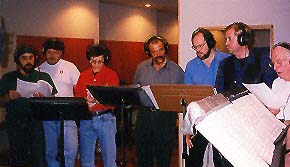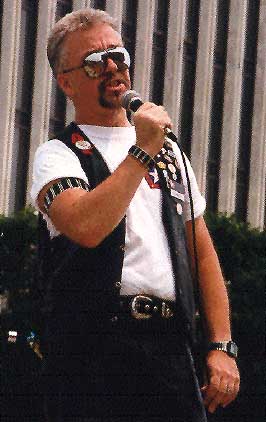Frequently
Asked Questions about
"One Common Heartbeat"
Who wrote "One Common Heartbeat?"
"One Common Heartbeat" was composed by Gary Aldrich. The lyrics were written by Aldrich and Kevin Tyrrell. See About the Creators.
![]()
Did anyone
else contribute?
There were many contributions from other sources. Considerable financial contributions notwithstanding, there was a vast number of people who dedicated time and effort in the creation of the piece. Musically, arrangements and orchestrations were written by Greg Speck, with arrangements and orchestration for the CD written by Chuck d'Aloia. Substantial conceptual contributions came from them, as well as Rob Turchick, Dick Johnson, Joseph Ricci, Barak Stribling, and E. Richard Tirado. This website contains an exhaustive list of contributors in every area of the song's creation and first performances. See Acknowledgments.
![]()
Why was the anthem written?
The seed for the anthem was planted by Chuck Renslow, producing director of International Mr. Leather, Chicago, in 1997. He perceived a need for a unifying musical symbol in the Leather Community and approached Gary Aldrich, who sang the National Anthem at IML 1997, to write it. See History of the Anthem.
![]()
Where and when was it first performed?
"One Common Heartbeat" had its first unofficial performance at Empire State Leather, Albany, NY, in April 1998. Aldrich, Tyrrell and Joseph Ricci were soloists for that performance, backed by several members of the Leather Community who attended ESL, members of STARS M.C., and a substantial contingent of the Capital Pride Singers, Albany's LGBT chorus. Its first "official" performance was at International Mr. Leather in Chicago on Memorial Day weekend -- May, 1998. The same soloists were flanked by members of the International Leather Community, several participants from the ESL performance, and the Chicago Gay Men's Chorus. It has since been performed at leather events throughout the United States and Canada. See History of the Anthem.
![]()
Was there any musical/textual inspiration for the anthem?
A great deal. According to Aldrich, the musical inspirations ran the gamut: from Strauss' Also Sprach Zarathustra to Metropolis to southern Baptist church hymns to God Save the Queen. The inspiration for the text was more personal, according to both Aldrich and Tyrrell, and was generated from philosophies of the Old and New Guard and the composers' own personal perspectives on what they felt the leather community, and community in general, should be about. See Lyrics.
![]()
Does the anthem accurately reflect today's Leather Community?
The anthem was created to represent an Ideal, rather than commenting upon what is actually happening in the "real" world. According to the authors, it's "a dream of how we feel the leather community could reach its highest aspiration. Something we're all striving for." Many of the ideas expressed in the song are very much contemporary and happening. Others: less so. According to the composers, "It's a song of hope."
![]()
How long did it take to create it?
From its first informal notes (according to Tyrrell, the first notes were scribbled on the back of a sheet of scrap paper in the front seat of a car on a return trip from a summer camp in Pennsylvania) written in August of 1997 to the completion of the CD in April 1999, the process took a year and eight months. The actual writing process took about 6 months, although changes continued to be made well after its first performances. See History of the Anthem.
![]()
Why didn't you include "xxxxx" in the anthem?
This was a difficult issue, according to the creators. One the one hand, including everyone's suggestions of what "should" be in the anthem would have made the song even longer than it is. Rather, they considered all suggestions offered and distilled them into slightly more general terms and blended them with their own ideas to arrive at the lyrics (see Lyrics) that were eventually written. Many people wanted specific sexuality and sexual practices included. The authors felt that the anthem needed to be inclusive in terms of issues of sexuality and thus treated specific sexual orientation as a non-issue. The same could be said of specific sexual practices: they attempted to avoid a "grocery list" of the myriad practices people enjoy.
![]()
There doesn't seem to be gender balance in the anthem (for example, more "man, brother, he" than "woman, sister, she, etc." Why?
The fact is that women are mentioned, frequently, in the anthem. (See Lyrics) "Brothers and sisters, our destination..." and "Brothers, sisters and lovers..." There is only one small section that appears "male-oriented" : "Care for your brother now, while he's living, etc." in the second verse. This came very much from a personal philosophy and experience of Kevin Tyrrell, whose history with it was in a male context. It seemed appropriate to both creators to include those particular lines from the heart, rather than try to make them politically correct. According to Aldrich, "man" and "brother" are still used most often in references to the "human race," as defined by The New Lexicon Webster's Dictionary of the English Language: "...the human race in general..." and they chose to so use such words in "One Common Heartbeat."
![]()
The anthem changes keys. Twice! Doesn't that make it hard for novices or amateurs to sing it?
Actually the song/melody itself does not change keys at all. (See Music) The ARRANGEMENT of the anthem on the CD does, specifically to heighten the excitement of those listening to it and those singing it. The process can be likened to writing something for a guitar or piano that is a simple melody line. Orchestrators and singers then take those simple lines and arrange them and generally tweak them to make them more interesting and moving to the listener. In addition, both the lead sheet (again, see Music), which does not change keys, and the "arranged (orchestrated)" versions on the CD, which do change keys twice, have been written in middle-voice keys so that a majority of people can sing them.
![]()
Can I alter the lyrics of the anthem? Or change the music?
No. Not legally, anyway. The lyrics and the melody were copyrighted to prevent people from arbitrarily changing them. The melody can, however, be arranged in any way a performer sees fit, including changing keys, adding a chorus, giving it a rock beat, doing an all-orchestral version of it, etc.
![]()
"One Common Heartbeat" seems very long. Is there a shorter version of it?
Absolutely. The Star-Spangled Banner originally had three or four verses, of which only the first is commonly sung. According to the creators, the same is true of "One Common Heartbeat." The anthem has two verses (see Lyrics) but singing only the first verse is certainly a valid option.
![]()
Can I purchase a copy of the anthem?
Yes. The CD is available from the Leather Archives and Museum in Chicago, IL. The Archives can be contacted directly about obtaining a copy. A copy of the lyrics and/or the music lead sheet can be taken directly from this website.
![]()
Can my club or organization obtain copies of the CD and then sell them at our events?
There are no restrictions on fundraising practices.
![]()
I'd like to have someone sing the anthem at my event. Can I?
Yes. Anyone can sing it.
![]()
 I'd
like to have Gary Aldrich sing the anthem at my event. Can that be arranged?
I'd
like to have Gary Aldrich sing the anthem at my event. Can that be arranged?
Aldrich's professional performing and teaching career (see About the Creators) keeps him from personally performing the anthem as often as he'd like, he says. However, there are instances where he is able to schedule a performance at an event. Such performances can be arranged as individual circumstances arise and permit. E-mail Gary to discuss the possibilities
![]()
Are there restrictions on the anthem's use?
There are no restrictions on its use. It was restricted only until the recording was finished, in May 1999. The composers felt it would have made no sense to have people trying to perform something that was not finished. It would not have made sense to release the anthem to the public domain before it was finished, any more than it would have made sense to fly a draft sketch of the Leather Pride flag before Tony [de Blase] finished it. It would have been unfair to the performers and to the piece. Many changes in the anthem occurred after its performance at IML 98.
![]()
If it is sung, does a royalty needs be paid?
There are no royalties, nor were there ever royalties, involved. To quote the original press information about this: "'One Common Heartbeat' is copyrighted so that, until the recording is released, the integrity of the piece is kept intact. The original and present intent is for the anthem to become public domain."
![]()
Is the anthem privately owned?
The recording was completed in the spring of 1999, when it was released nationally. There is no private "ownership," although the melody and lyrics themselves are copyrighted to prevent their being altered. It is completely in the public domain and has been since its official release.
![]()
To sum up, a note from composer Gary Aldrich:
"A great deal of time, effort, thought, and sweat went into creating One Common Heartbeat. As in any creative effort, it has been met with much misunderstanding and more than a little controversy.
"I won't go into whether or not I felt there was a 'need' for a leather anthem. I was asked to create one, and my collaborator and I did that. Many people like it. But there are people in the community who have been so vitriolic about their response to it that it truly boggles my mind. As Dave Rhodes wrote last year in the Leather Journal: 'No good deed goes unpunished.'"